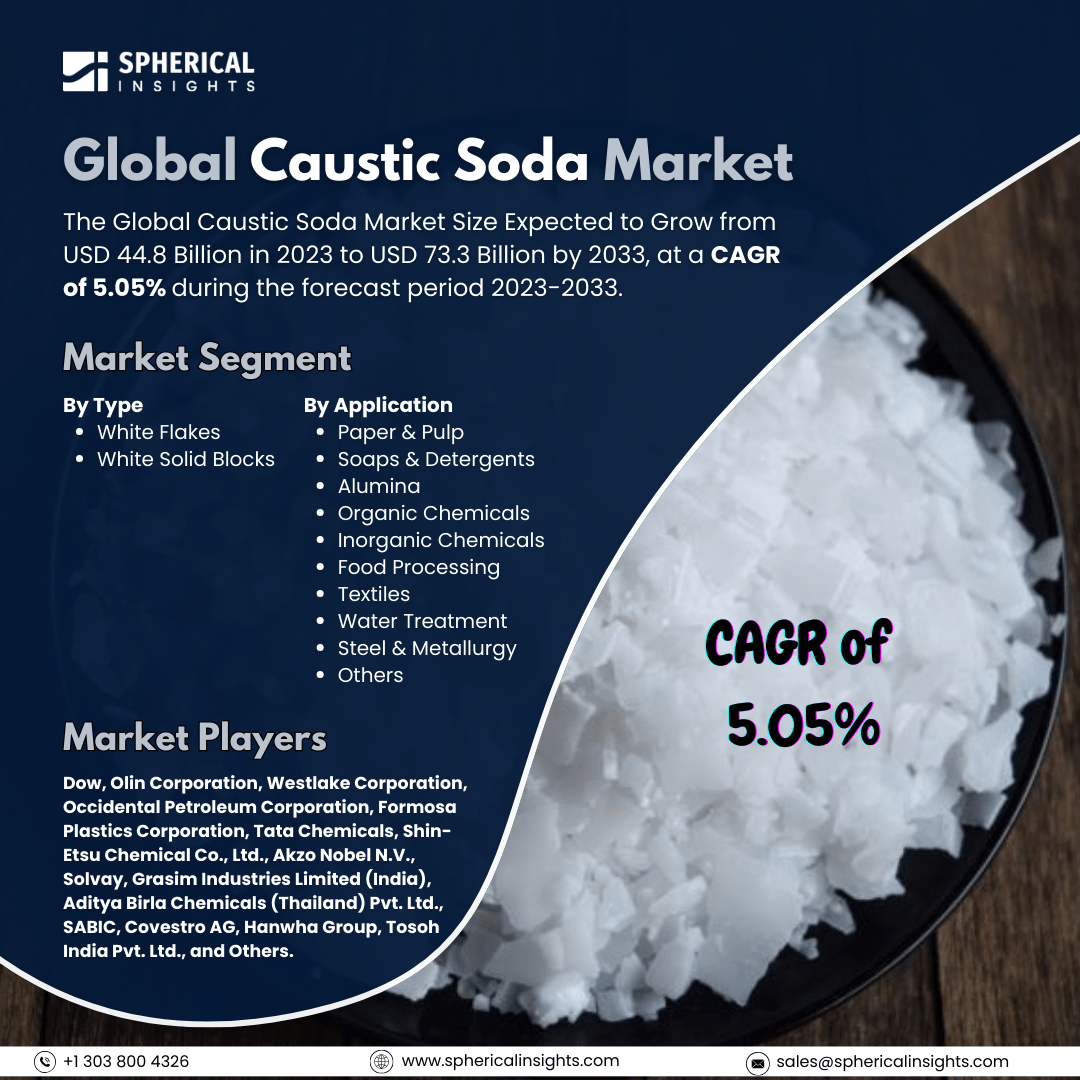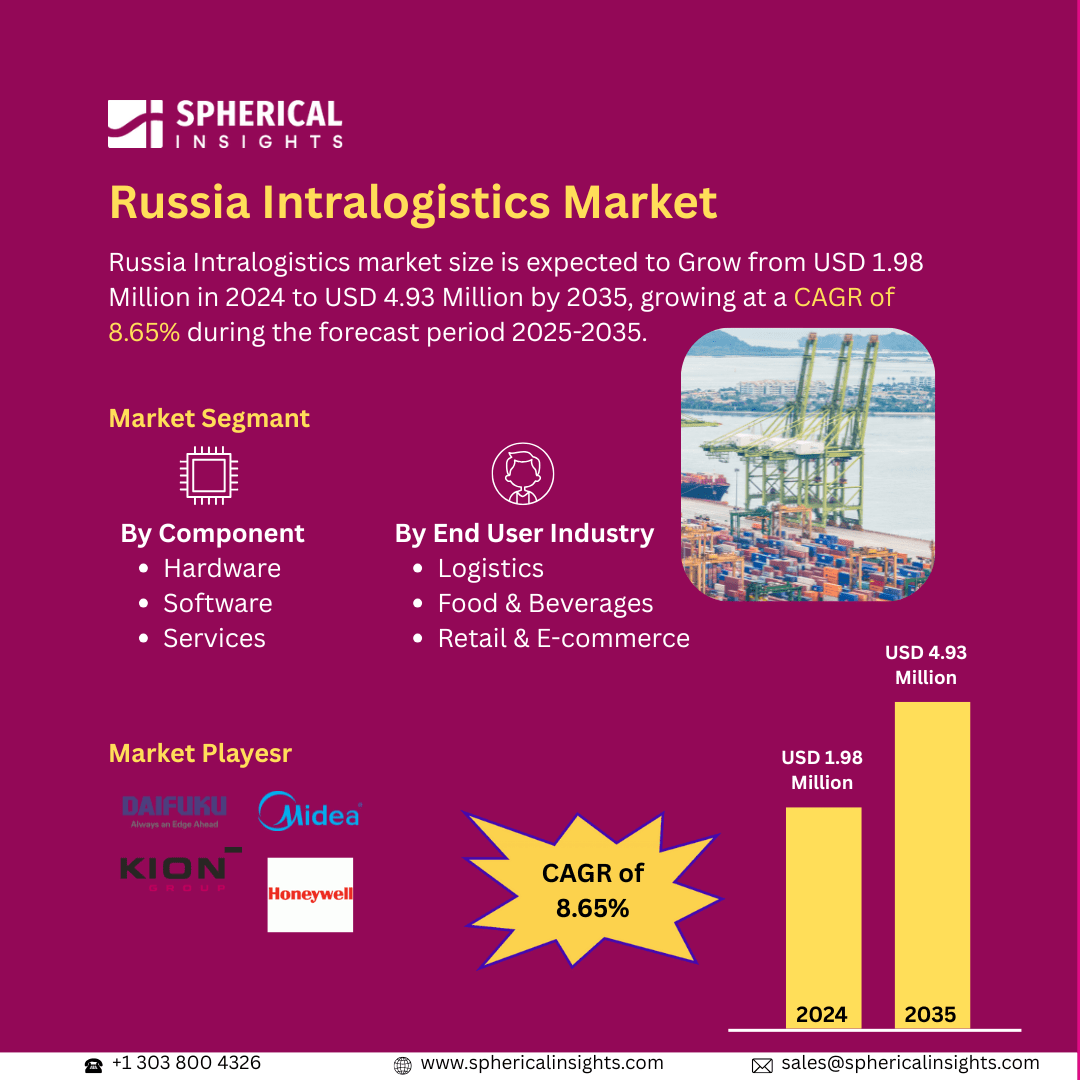Global Caustic Soda Market Size to Exceed USD 73.3 Billion by 2033
According to a research report published by Spherical Insights & Consulting, The Global Caustic Soda Market Size Expected to Grow from USD 44.8 Billion in 2023 to USD 73.3 Billion by 2033, at a CAGR of 5.05% during the forecast period 2023-2033.
Browse 210 market data Tables and 45 Figures spread through 190 Pages and in-depth TOC on the Global Caustic Soda Market Size, Share, and COVID-19 Impact Analysis, By Type (White Flakes and White Solid Blocks), By Application (Paper & Pulp, Soaps & Detergents, Alumina, Organic Chemicals, Inorganic Chemicals, Food Processing, Textiles, Water Treatment, Steel & Metallurgy, and Others), and By Region (North America, Europe, Asia Pacific, Latin America, Middle East, and Africa), Analysis and Forecast 2023 – 2033
The caustic soda market refers to the global industry encompassing the manufacturing, distribution, and consumption of caustic soda, that is, sodium hydroxide, NaOH, a chemical that is both highly alkaline and versatile in its applications. Moreover, the caustic soda market is driven by rising demand in pulp & paper, textiles, and chemical manufacturing, along with growth in water treatment and alumina production. Expanding industrialization, urbanization, and infrastructure development fuel consumption. Technological advancements in chlor-alkali production and increasing focus on wastewater treatment further boost demand. In addition, the rising food processing applications and stringent environmental regulations on industrial effluents support market growth globally. However, the caustic soda market faces restraining factors in volatile raw material prices, energy-intensive production processes, environmental constraints through regulations for the disposal of wastes, and issues of safety regarding its high corrosive characteristics and risks during handling.
The white flakes segment accounted for the largest share of the global caustic soda market in 2023 and is anticipated to grow at a significant CAGR during the forecast period.
On the basis of type, the global caustic soda market is divided into white flakes and white solid blocks. Among these, the white flakes segment accounted for the largest share of the global caustic soda market in 2023 and is anticipated to grow at a significant CAGR during the forecast period. The segmental growth due to their high solubility, ease of handling, storage, and transportation, they are widely used in pulp & paper, textiles, chemicals, and water treatment industries, hence more commercially preferred compared to white solid blocks that require additional processing.
The paper & pulp segment accounted for a substantial share of the global caustic soda market in 2023 and is anticipated to grow at a rapid pace during the projected period.
On the basis of application, the global caustic soda market is divided into paper & pulp, soaps & detergents, alumina, organic chemicals, inorganic chemicals, food processing, textiles, water treatment, steel & metallurgy, and others. Among these, the paper & pulp segment accounted for a substantial share of the global caustic soda market in 2023 and is anticipated to grow at a rapid pace during the projected period. This is because it is widely applied in pulping, bleaching, and de-inking operations. The upsurge of demand for packaging materials, tissue paper, and sustainable paper products, driven by e-commerce, environmental concerns, and industrialization, further increases its market stronghold.
Asia Pacific is projected to hold the largest share of the global caustic soda market over the projected period.
Asia Pacific is projected to hold the largest share of the global caustic soda market over the projected period. This is due to high industrial demand from China, India, and Southeast Asia, driven by rapid urbanization, strong manufacturing sectors, and expanding pulp & paper, textiles, and chemical industries. Moreover, China's dominance in alumina production and large-scale chlor-alkali manufacturing capacity further enhances the market growth of this region.
North America is expected to grow at the fastest CAGR growth of the global caustic soda market during the projected period. The demand is strong from the chemical, pulp & paper, water treatment, and alumina industries. Caustic soda consumption will continue to increase in the U.S. with its demonstrated leadership in advanced chlor-alkali production technology, growing industrial applications, and stringent environmental regulations that drive wastewater treatment needs.
Company Profiling
Major vendors in the global caustic soda market are Dow, Olin Corporation, Westlake Corporation, Occidental Petroleum Corporation, Formosa Plastics Corporation, Tata Chemicals, Shin-Etsu Chemical Co., Ltd., Akzo Nobel N.V., Solvay, Grasim Industries Limited (India), Aditya Birla Chemicals (Thailand) Pvt. Ltd., SABIC, Covestro AG, Hanwha Group, Tosoh India Pvt. Ltd., and Others.
Key Target Audience
- Market Players
- Investors
- End-users
- Government Authorities
- Consulting and Research Firm
- Venture capitalists
- Value-Added Resellers (VARs)
Recent Development
- In December 2023, Dow introduced two caustic soda products - Caustic DEC and TRACELIGHT DEC, part of Decarbia, to reduce carbon with up to 90% lower carbon dioxide. This will help customers achieve sustainability goals with the same quality of the product.
Market Segment
This study forecasts revenue at global, regional, and country levels from 2023 to 2033. Spherical Insights has segmented the global caustic soda market based on the below-mentioned segments:
Global Caustic Soda Market, By Type
- White Flakes
- White Solid Blocks
Global Caustic Soda Market, By Application
- Paper & Pulp
- Soaps & Detergents
- Alumina
- Organic Chemicals
- Inorganic Chemicals
- Food Processing
- Textiles
- Water Treatment
- Steel & Metallurgy
- Others
Global Caustic Soda Market, By Regional
- North America
- Europe
- Germany
- UK
- France
- Italy
- Spain
- Russia
- Rest of Europe
- Asia Pacific
- China
- Japan
- India
- South Korea
- Australia
- Rest of Asia Pacific
- South America
- Brazil
- Argentina
- Rest of South America
- Middle East & Africa
- UAE
- Saudi Arabia
- Qatar
- South Africa
- Rest of the Middle East & Africa



